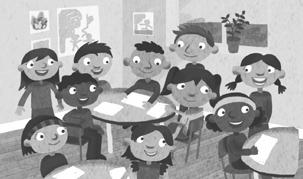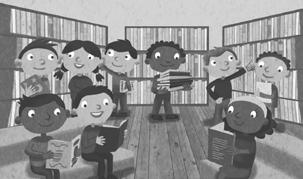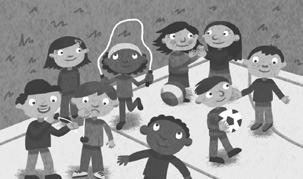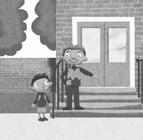This is a SEO version of Ace TB1 Cubierta.indd. Click here to view full version
« Previous Page Table of Contents Next Page »19 Tour of a unit
Lesson 8 Culture
Lesson 8 provides key cultural input, focusing on a particular cultural aspect of children living in Great Britain. The children practise reading an extended text and learn four new vocabulary items.
Class Book
• The children use known words to anticipate the meaning of the text and guess what it is likely to be about. They find the words in the pictures or text before reading it.
• The children listen to the text and follow it on the Class Book page.
Activity Book
• In the first activity, the children listen to and identify the meaning of four new culture words from the Class Book by choosing the correct picture.
• In the second activity, they practise recognizing the new vocabulary items through a game.
0 Lesson 0
Finished? Finished? What have you got? Write e.g. I've got a brush, I've got a towel .
1111
Finished? Finished? How many boys and girls are in your classroom? Count and write.
1 Lesson 8
1 Listen and say the number. $ CD1
31



School
4 3 2
classroom
6
girls
boys
2 Read and look. Count and write the numbers.
2

3 4


1

library
girls
boys
school
girls
boys
playground
girls
boys
1

AB1.indb 11 02/09/2011 10:21

Class Book 1
Activity Book 1 Teacher’s Book 1
39 Unit 1
• Photo 2: What’s this? (a classroom). Who’s this? (the teacher) What colour is the desk / board? (red / green)
• Photo 3: What’s this? (a library) What can you see? (books)
• Photo 4: What’s this? (a playground) What can you see? (boys and girls) Howmany boys and girls are there? (eight)
KEY COMPETENCE: Artistic and cultural competence Beginning to see similarities and differences between the children’s own culture and the target culture is an important part of their learning. Encourage the children to compare the British school in their Class Book with their own school by asking questions about the children’s school, e.g. Is your school big or small? What colour is the door? What colour are the windows? Can you see pens and pencils in the classroom? What colour are the desks? What colour is the board? Can you see a library in your school? Can you see a playground?
Activity Book
1 Listen and say the number. $ 1•31
• Ask the children to open their Activity Books and look at the pictures in Activity 1.
• Tell the children to listen and say the number of the picture that matches the phrase they hear.
• Play the recording, pausing after each phrase and eliciting the number of the corresponding picture.
Transcript
Listen and say the number.
This is the library. This is the school. This is the playground. This is the classroom.
Answers
3 1 4 2
2 read and look. Count and write the numbers.
• Ask the children to look at Activity 2 and the example.
• Tell the children to count the numbers of boys and girls in each place in the school and write the numbers in the boxes.
• Check the activity by pointing to each picture and eliciting the number of girls and boys.
Answers
classroom 6 girls, 4 boys library 2 girls, 7 boys playground 4 girls, 5 boys school 3 girls, 2 boys
CulTural NOTE: Primary schools in england Children start primary school at the age of four or five, depending on when their birthday falls. At primary school, children are mostly taught by the same teacher for all subjects. Primary schools are often subdivided into infant schools for children aged four to seven (Foundation Stage and Key Stage 1) and junior schools for ages seven to eleven (Key Stage 2). Primary school children in England sit standardized tests called ‘SATs’ in Year 2 and Year 6.
Lesson 8
CB page 12 and AB page 11
CULTURE AND INTEGRATED SKILLS LESSON
Lesson objectives
Raise awareness of British culture. Present and practise school-related vocabulary. Develop integrated skills.
Language
Core: books, pens and pencils, a door, windows, boys and girls, a teacher, school, classroom, library, playground, This is (my school), Lesson 1 colour words, Lesson 4 school object words
extra: small, big, Look! Howmany (boys and girls) are there?
Materials
CD1 $ tracks 30–31
warmer
• Play a spelling game.
• Divide the class into two teams, A and B. Say a word from Lesson 7 Class Book Activity 1.
• Choose a child from Team A to come to the front of the class and spell the word. If he / she is right, his / her team gets one point.
• Repeat and this time choose a child from Team B. If a child spells the word incorrectly, the word is offered to the other team.
• The team with the most points is the winner.
Lead-in
• Ask the children to open their Class Books and look at the photos. Ask the children what the photos show (a school). Establish that it isn’t a school in their country. It’s a school in Great Britain.
Class Book
1 Find and point.
• Ask the children to look at the photos again and find each of the items in Activity 1, one by one.
• Ask, e.g. Where are the books? and encourage the children to tell you the number of the photo.
Answers
books Photo 3 pens and pencils Photo 2 a door Photo 1 boys and girls Photos 2, 4 a teacher Photo 2
2 Listen and read. $ 1•30
• Play the recording all the way through, encouraging the children to listen and read.
Answer your teacher’s questions.
• Play the recording again, this time pausing after each paragraph and photo to ask questions.
• Photo 1: What’s this? (a school) Is it big or small? (It’s small.) What colour is the door / are the windows? (green / white)
Real photos of different aspects of UK culture to increase children’s intercultural awareness.
Listening activity to practise culture vocabulary.
Pre-reading activity to familiarize children with the cultural topic and the reading task.
Carefully supported extended reading.
Full cultural teaching support via notes in the Teacher’s Book.
Practice of new vocabulary and consolidation of the cultural information.
This is a SEO version of Ace TB1 Cubierta.indd. Click here to view full version
« Previous Page Table of Contents Next Page »